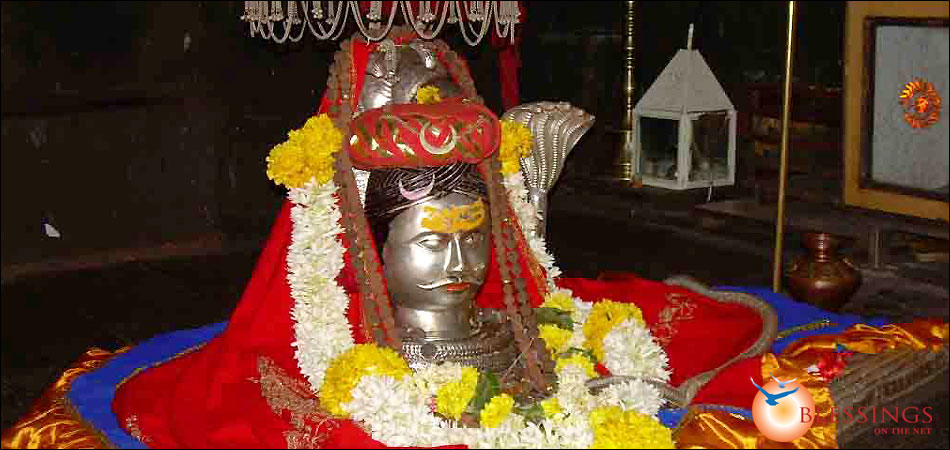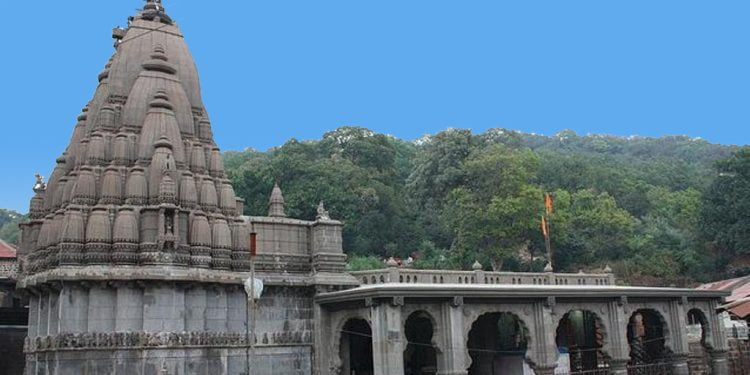Bhimashankar Templeis aJyotirlingashrine located 50km north-west ofKhed, nearPune, in India. It is located 127km from Shivaji Nagar (Pune) in theGhat regionof theSahyadri hills. Bhimashankar is also the source of theriver Bhima, which flows south-east and merges with theKrishna rivernearRaichur.
Shrine’s History
Many decades ago,in the dense forests of Dakini, on the lofty ranges of the Sahaydris lived the evil Asura by the name Bhima with his mother Karkati. Compassion and kindness shivered in the presence of Bhima. The divine and the mortals feared him alike. But he was confronted by certain questions about his own existence which continuously tormented him.
When Bhima could no longer sustain his agony and curiosity, he asked his mother to unveil the mysteries of his life. He urged his mother to tell him who his father was and why had he abandoned them in the wilderness of the forest. After much hesitation and with a lingering fear Karkati, his mother revealed to him that he was the son of the mighty Kumbhakarna, the younger brother of the Lankadhishwar the mighty all-powerful King Ravana of Lanka. Lord Vishnu in his incarnation as Lord Rama annihilated Kumbhakarna.
Karkati told Bhima, that her husband and his father was killed by Ram in the great war. This infuriated Bhima and he vowed to avenge Lord Vishnu. To achieve this he embarked on a severe penance to please Lord Brahma. The compassionate creator was pleased by the dedicated devotee and granted him immense powers. This was a terrible mistake that Brahma did. The evil tyrant caused havoc in the three worlds. He defeated King Indra and conquered the heavens.
He also defeated a staunch devotee of Lord Shiva – Kamarupeshwar and put him in the dungeons. He started torturing Rishis and Sadhus. All this angered the Gods. They all along with Lord Brahma beseeched Lord Shiva to come to their rescue. Lord Shiva consoled the Gods and agreed to rescue them from the tyrant. On the other hand, Bhima insists and orders Kamarupeshwara to worship him instead of Lord Shiva. When Kamarupeshwara denied doing that and refused to do pooja to him, tyrant Bhima raised his sword to strike the Shiva Linga, to which Kamarupeshwar was doing abhisheka and pooja.
As soon as Bhima managed to raise his sword, Lord Shiva appeared before him in all his magnificence. Then the terrible war began. But then the holy sage Narada appeared and requested Lord Shiva to put an end to this war. It was then that Lord Shiva reduced the evil demon to ashes and thus concluded the saga of tyranny. All the Gods and the holy sages present there requested Lord Shiva to make this place his abode. Lord Shiva thus manifested himself in the form of the Bhimashankar Jyotirlinga.
It is believed that the sweat that poured forth from Lord Shiva’s body after the battle formed the Bhimarathi River. This temple is strongly associated with the legend of Shiva slaying the demon Tripurasura associated with the invincible flying citadels Tripura. Shiva is said to have taken abode in the Bhima form, upon the request of the Gods, on the crest of the Sahyadri hills, and the sweat that poured forth from his body after the battle is said to have formed the Bhimarathi river.

Legends Associated with This Shrine
According to the legends, once a demon called Bhima lived with his mother Karkati in the dense forests of Dakini, on the lofty ranges of the Sahaydris. It is said that Bhima was so cruel that everyone feared him. But what tormented Bhima was his curiosity regarding his own existence. One day, Bhima urged his mother to tell him who his father was and why had he abandoned them in the wilderness of the forest. His mother revealed that he was the son of Kumbhakarna, the younger brother of the mighty King Ravana – the King of Lanka. Bhimas mother Kartaki also told him that Lord Vishnu in his incarnation as Lord Rama annihilated Kumbhakarna. This infuriated Bhima and he vowed to avenge Lord Vishnu.
Bhima performed severe penance to please Lord Brahma. The compassionate creator was pleased by the dedicated devotee and granted him immense prowess. With so much power, Bhima began to cause havoc in the three worlds. He defeated King Indra and conquered the heavens. He also defeated a staunch devotee of Lord Shiv – Kamrupeshwar and put him in the dungeons. All this angered the Gods and them along with Lord Brahma beseeched Lord Shiv to come for their rescue to which Lord Shiv agreed.
Tyrant Bhima asked Kamrupeshwar to worship him instead of Lord Shiv. When Kamrupeshwar refused, Bhima raised his sword to strike the Shiv Linga. But as soon as he raised his sword, Lord Shiv appeared before him in full magnificence. Then the terrible war began. Holy sage Narad appeared and requested Lord Shiv to put an end to this war. It was then that Lord Shiv reduced the evil demon to ashes and thus concluded the saga of tyranny. All the Gods and the holy sages present their requested Lord Shiv to make this place his abode. Lord Shiv thus manifested himself in the form of the Bhimashankar Jyotirlinga. It is believed that the sweat that poured forth from Lord Shivs body after the battle formed the Bhimarathi River.
Architectural Relevance of This Shrine
Bhimashankara Temple is situated in a picturesque extreme end of the Sahayadri Ranges and provides a wonderful view of the forts, the rivers and the hill stations around. The dense forests surrounding the high ranges also play an abode to the rare species of flora and fauna.
Bhimashakara Temple dates back to mid 18th century and is a composite of old and the new structures and is built in the Nagara style of architecture. The shikhara of the temple was built by Nana Phadnavis. Shivaji – the great Maratha ruler is said to have facilitated the carrying out of worship services. As with other Shiv temples in this area, the sanctum is at a lower level. The best time to visit the Bhimashankar Temple is said to be Maha Shivaratri as the temple organises grand festivities on the occasion.
Shrine’s Map Location and How to Go There
By Road
Bus:Bhimashankar is located in the Bhorgiri village which is at a distance of only 50km from Khed, Rajguru Nagar. It is at a distance of 125km from Pune and takes around three and a half to four hours to reach. Road distance from Mumbai and Nasik is around 240km and 215 km respectively and Bhimashankar can be reached from these two places in well within 6 hours. How to Reach Bhimashankar from Pune: From Pune one can travel through Rajguru Nagar and Manchar to reach Bhimashankar Wildlife Sanctuary. How to Reach Bhimashankar from Mumbai: From Mumbai travel through Talegaon and Chakan to reach Manchar and then reach Bhimashankar Wildlife Sanctuary via Taleghar. Travellers can reach Manchar from Nasik directly and then travel to Bhimashankar via the same route as above.
By Rail
The nearest Railway Station is Pune Railway Station, located at 111 Kms from the city. It is linked with the cities like New Delhi, Mysore, Lucknow, Chennai, Puri and Jaipur via Udyan Express, Gandhidham Express, Mumbai Express, Mumbai Mail, Rajkot Express, Pune Shatabdi, Mahalaxmi Express and Cstm Latur Express.
By Air
The nearest International Airport is Pune Airport, roughly two- and half-hour drive from Bhimashankar. Pune Airport is well connected to a spectrum of cities like Bangalore, Chennai, Delhi, Hyderabad, Indore, Kolkata, Mumbai and Kochi via Jet Airways, Air India, Air India Express, Go Air, Indigo and Kingfisher Airlines.
Shrine Timings
Timings:
Mandir open – 4:30 am
Aarti – 4:45 am to 5.00 am
Najar up (Original shiv linga)darshan – 5:00 am to 5.30 am
Normal Darshans and Abhishekam – 5:30 am to 2:30 pm.
No Abhishekam between – 12:00 pm to 12:30 pm.
Maha Puja (Naivedya Pooja) – 12.00 pm. to 12.30 pm
Aarti – 3:00 pm to 3:30 pm
Shringar Darshans – 3:30 am to 9:30 pm.
Aarti – 7:30 pm to 8:00 pm
(Except Pradosham on Monday or Amavasya or Grahan or Mahashivratri. Karthika Month, Shravan Month? No Mukut and no Shringar Darshans).
Events Celebrated at This Shrine
Mahashivarathri
Extra Information About this Shrine
The best time to visit is between August and February. Though any time of the year is good to visit Bhimashankar, it is better to avoid visiting during summer. Similarly during monsoon, unless one likes trekking, it is better to avoid. That leaves the best period to seven months between August and February.













































